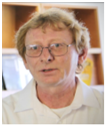
Dr. Bruno Wacogne
FEMTO-ST Institute, France
Title: White light spectroscopy of ESKAPEE bacteria: optical properties, culture monitoring and determination of optimal wavelength optical density measurements
Abstract:
White light spectroscopy is an historical method used to evaluate the properties of biological entities. It has been used for various purposes, but more specifically to measure the concentration of cells or bacteria. One application of white light spectroscopy is the well-known Beer–Lambert law, which relates optical absorbance to cell or bacterial concentrations, but this is restricted to the use of a single wavelength. However, the molar absorptivity coefficient involved in this law is wavelength-dependent, meaning that much more information can be obtained by considering the entire absorbance spectrum of cell or bacterial suspensions.
In this presentation, we will present studies performed on some representative bacteria belonging to the ESKAPEE group. These bacteria are pathogens that are known for their ability to 'escape' the effects of antibiotics, particularly in hospital settings. Often multi-drug resistant, these bacteria pose a significant threat to public health due to their role in healthcare-associated infections. They therefore represent an ideal model group for studying bacteria.
The studies presented here concern the mathematical description of the absorption spectra of ESKAPEE bacteria. Principal component analysis shows that, while not identical, these bacteria behave similarly in terms of their optical properties. Considerations are proposed on the relationship between optical absorbance and bacteria concentrations, particularly with regard to wavelength dependency. Traditionally, bacterial concentration is determined from the absorbance value measured at a single wavelength. The choice of wavelength is based on laboratory practices rather than rational consideration. An objective method for selecting the optimal wavelength at which to measure absorbance will conclude the conference.
Biography:
Dr Bruno Wacogne is a CNRS Research Director at the FEMTO-ST Institute (one of the biggest Science and Technologies laboratory in France) where he was the head of the "Photonics for medical instrumentation" team before to join the BioMicroDevices group and then the BIND group. He created the Biom'@x transversal axis "Science et technology for personalized medicine" within this Institute. In 2010, at the request of Besançon University Hospital, he applied and has been awarded a Translational Research Fellow position from the National AVIESAN Alliance. This is a supplementary position that allows him to be at the interface between the health activities at the FEMTO-ST Institute and the Clinical Investigation Center in Technological Innovation at Besançon University Hospital. At the hospital, he is now the technological supervisor of the institution and the head of "Microsystems and biological qualification" unit.
His research interests concern translational research, science and technology for health and more precisely immuno-combined medical devices, biological qualification devices and biomedical optics. He is author or co-author of about 230 communications among which 10 patents, 1 invited paper and about 30 invited conferences and keynote lectures. He is regularly chairman in international conferences and he co-organized the 14th International conference BIODEVICES in 2021. He has been awarded several times: Gold Micron at the International MICRONORA Workshop, Best Poster Award at the 2nd International Conference on Bio-sensing Technology, Amsterdam, The Nederlands. With his co-authors including A. Frelet-Barrand, he received the Best Paper Award at the 13th International Conference BIOSTEC in 2020.
___________________________________________________________________
Dr Annie FRELET-BARRAND studied biochemistry at the University of Franche-Comté (France) and was graduated as MS in 1998. In 2006, she received her PhD degree on membrane proteins (MP) characterization at the Institute of Plant Biology, Zurich. During her postdoctoral fellowship (CEA Grenoble, France), she developed L. lactis system for functional characterization of MPs. In 2009, she became CNRS Researcher at CEA Saclay, studying MPs involved in liver detoxification. In 2015, she integrated the Institute FEMTO-ST and is now producing and characterizing by biological, biochemical and biophysical techniques diverse biological elements from MPs, vesicles to bacteria and mammalian cells. She published 22 research articles and 4 book chapters (h=17).
___________________________________________________________________
During his studies, Alain Rouleau specialized in Biology including immunology, physiology, oncology and the design of devices for in vitro diagnostics. He currently works at the femto-st institute (Besançon, France). He is involved in bio-interaction projects (SPR), development of sensors for the detection of biological elements (biointerfaces) as well as their characterizations (optical, biochemical and biophysical). He is also technical manager of the CLIPP proteomic platform in Besancon.
___________________________________________________________________
After graduating in Biotechnology Engineering from the Ecole Supérieur d'Ingénieur de Luminy in 2004, Marjorie Robert-Nicoud acquired solid experience both abroad at Oxford BioMedica (Oxford, UK) as research scientist and in France at IATEC France as clininal research associate. From 2009 to 2014, she worked as laboratory manager at the French National Reference Center for Antibiotic Resistance in Besançon. In January 2015, she joined Smaltis, a CRO offering services in microbiology, as project manager, and is now also responsible for the management and development of the company's quality system.